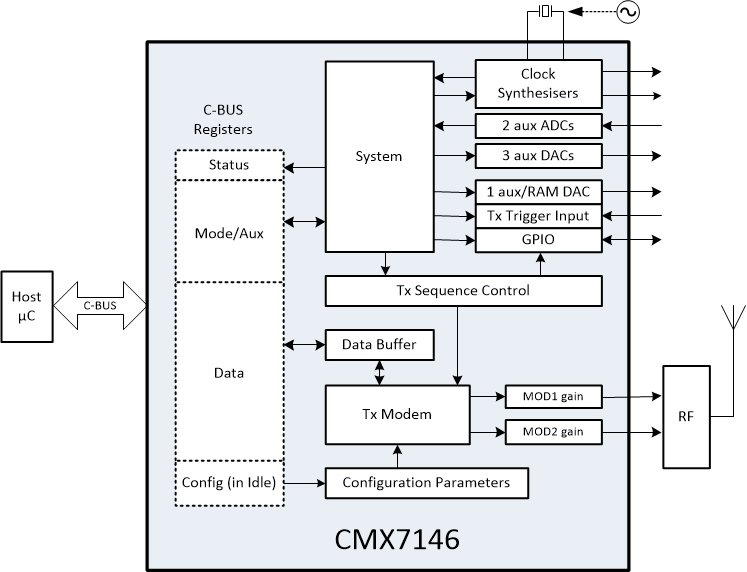The falling costs of space access have stimulated a recent surge in the numbers of small satellites and CubeSats being launched into Low Earth Orbit, (LEO). These satellites offer new opportunities to developers of remote IoT applications, making satellite communication economically as well as technically feasible. Due to their small size and limited power-budget, CubeSats often use BPSK as a modulation technique, owing to its relatively simplicity and robust performance compared to other modulation types. Although BPSK limits the amount of data that can be communicated, this is not an issue for a large proportion of remote IoT applications which tend to send small status update messages at periodic intervals.
As the growth in numbers of CubeSats enables more and more remote IoT applications to benefit from direct satellite communication, the demand for sensors using BPSK modulation is set to grow. Designing a BPSK transmitter from scratch requires multiple skill sets and developers focused on getting to market quickly can shorten the development cycle by integrating purpose-built platforms, such as CML Microcircuit’s CMX7146 flexible transmitter, into their design.
Wireless Communications is Key to Future IoT Growth
The phenomenal growth of the IoT shows no signs of abating any time soon, with Ericsson predicting that, by 2022, 18 billion of the world’s 29 billion connected devices will be related to IoT. For many use cases, including connected cars, machines, meters, wearables and other consumer electronics, mobility is a key factor and reliable wireless data communications has become a critical enabler of the growth of the IoT. Short-range wireless technologies including Wi-Fi, Bluetooth and Zigbee simplify the installation of in-building applications such as security access and fire-detection systems and avoid the cost of expensive and inflexible cable runs. For applications requiring longer range connectivity, much work has been done by 3GPP to standardise cellular IoT technologies, driving the development of 5G and also of Low Power Wide Area, (LPWA), protocols such as NB-IoT and LTE-M.
Not all IoT Applications are Equal
These protocols recognise that low power consumption and long transmission range are priorities for applications such as meter reading and remote sensing. Although communicating with low power over long distances usually allows only small amounts of data to be transmitted at a time, this generally isn’t a limiting factor for this class of applications. For example, even though it may it be may be mission critical, communicating the failure of a remote pump requires very little data; an error condition can be conveyed by a simple range of numbers, as can a whole range of status information. The same goes for remote meters, traffic lights and many more applications.
Connectivity using LPWA protocols is however only possible where there is access to a terrestrial network, which is often not the case, for example with remote mountain-top weather stations, SAR beacons and shipping container tracking.
The Rejuvenation of Satellite Communications
For these applications satellite communication is the only feasible option and, historically, only very high volume or extremely mission critical applications could justify the high cost of satellite access. In recent years, however, the cost of access to space has been decreasing, with organisations such as Space-X dramatically driving down launch costs, stimulating a growth in the launch numbers of small satellites, including CubeSats. This growing popularity of small satellites is opening multiple opportunities for developers to quickly and cheaply implement satellite projects for a variety of applications, such as remote sensing and measurement and scientific experiments.
Improved space economics are driving popularity of Cubesats
(Source: http://www.asc-csa.gc.ca/eng/satellites/cubesat/what-is-a-cubesat.asp)
Recognising this trend towards satellite IoT applications using BPSK modulation, UK-based CML Microcircuits has released the CMX7146 flexible data transmitter.
The flexibility of this device is unique on the market, providing a rapid and simplified approach to the deployment of a BPSK transmitter to developers without specialist knowledge, accelerating the development cycle and reducing time to market. The CMX7146 IC also offers onboard sensor interfacing functionality and has built-in, over-the-air, (OTA), futureproofing capability, based on CML’s proven FirmASIC® technology.
CML’s CMX7146 BPSK Transmitter IC
CML; Experts in Narrowband Communications
The CMX7146 is another example of CML’s narrowband-focused product portfolio. With over 50 years of experience, CML Microcircuits is a world-leader in the design, development and supply of low-power analogue, digital and mixed-signal semiconductors and CML’s ICs are found in a wide range of digital/analogue PMR/LMR, wireless data, satellite communications and marine radio applications for telecommunications systems globally.
To read more on the CMX7146, visit the product page here.






